Dear reader: This article contains links to products and services that I may be compensated for, at no extra cost to you.
Penghu (澎湖) is a collection of islands in the Taiwan Strait between Taiwan and China. It is also called the Penghu Islands, Penghu Archipelago, and Pescadores Islands. Penghu County is one of Taiwan’s 13 counties and is made up of around 90 islands.
Penghu is an incredibly special place. Consider this list of fun things to do in Penghu: a months-long fireworks festival, more temples per capital than any county in Taiwan (including the country’s oldest!), the best beaches in Taiwan, traditional houses made of coral, volcanic basalt columns, heart-shaped fish weirs, snorkelling in fields of lavender coral, windsurfing, island hoping, and so much more. Penghu also has a uniquely dry, windswept landscape with cacti that are used to make delicious ice cream.
I’ve been to Penghu three times: with my wife, with my sister, and with my kids and Taiwanese family. It is one of my absolute favorite places in Taiwan and my top choice when it comes to the offshore islands of Taiwan.
I’ve spend countless hours researching and exploring the islands, and I would go again in a heartbeat. Instead of writing multiple guides to Penghu (itinerary, activities, places to visit, getting there, where to stay, what to eat, tours, and more), I’ve decided to put it all together in this enormous (you might even call it the “ultimate”) Penghu guide!
Speaking of offshore islands in Taiwan, also see my guides to Orchid Island, Xiaoliuqiu, and Cijin!

Table of Contents
When to Visit Penghu
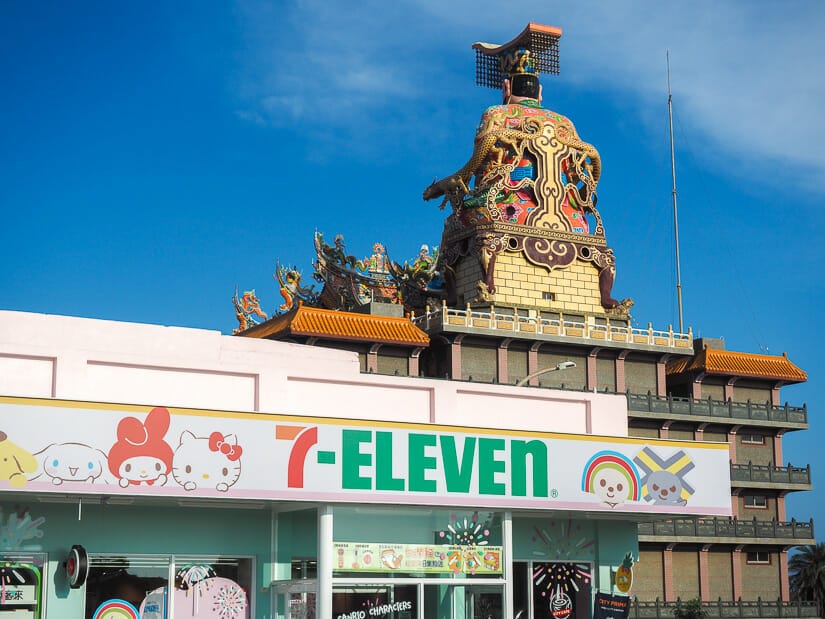
The best time to visit Penghu is in spring, summer, or early autumn, from April to September. In my opinion, April, May, June and September are the best months to visit Penghu. May and June have the Penghu International Fireworks Festival but are also quite busy as a result.
July and August are the busiest time to visit Penghu. But the heat in summer in Penghu can be overbearing. Because the islands are mostly flat and there aren’t many trees, there is little shade to escape from the sun.
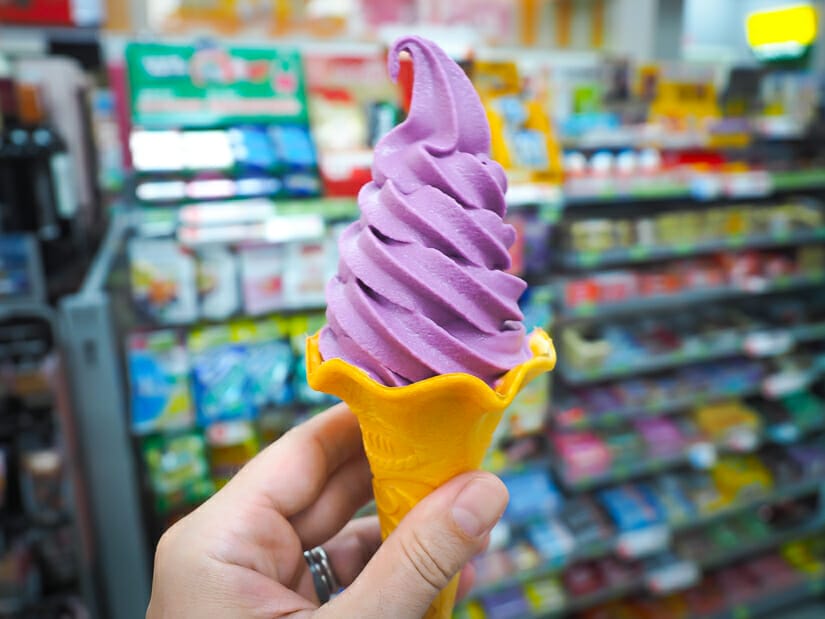
Penghu is actually one of the few places in Taiwan where I’ve ever got a bad sunburn. Most things to do in Penghu are outdoors, not to mention that the main way to get around is by scooter, on which you are totally exposed.
I highly recommend bringing strong sunscreen and thin but long-sleeved shirt and long pants for riding around.

It is not recommended to visit Penghu in winter, from October to March. At this time, the archipelago experiences unusually strong wind because there are no hills or trees to stop it. I’ve heard the wind can be strong enough to knock people over when they are riding scooters. One exception is if you are going to Penghu specifically for windsurfing.
Learn more in guide to the best time to visit Taiwan.
Getting to Penghu
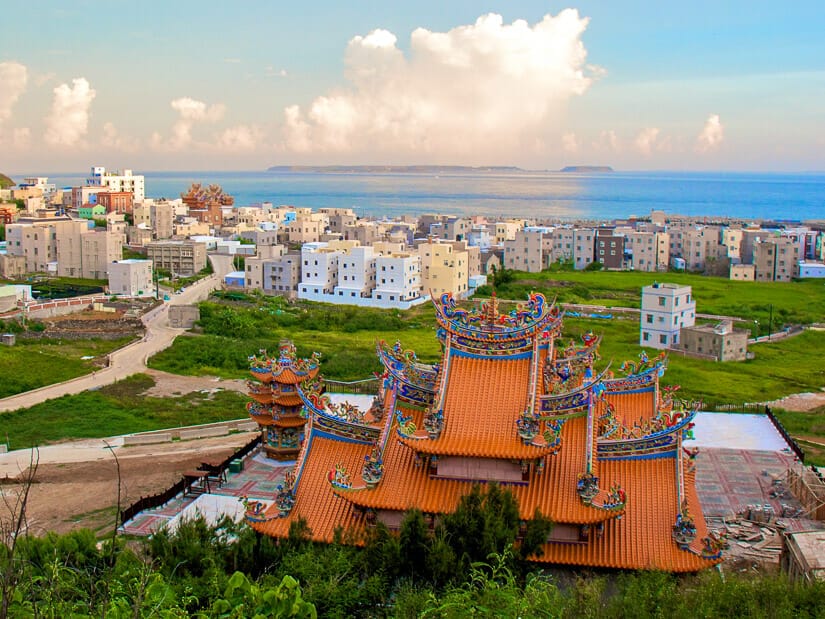
One of the most convenient aspects of visiting Penghu is that there are regular flights every day from several cities in Taiwan. All of these flights land in Magong (MZG), the capital city of Penghu county.
You may want to consider a package deal to Penghu. These are generally cheaper than buying each item individually.
You can also get to Penghu by ferry from the mainland of Taiwan. But just like the ferry rides to any of Taiwan’s offshore islands, the journey can be rough, and seasickness is common among passengers.
Package Deals
While I’m not normally a “package deal” kind of traveler, both Penghu and Green Island in Taiwan have some high value package deals. In fact, most Taiwanese people purchase such packages when they visit the islands, and there are numerous travel agents in Taiwan offering them. These deals include, at the minimum, a return flight from Taipei’s city center Songshan Airport and a hotel in Penghu.
The main benefit of these packages is that you can score a room in a fancier hotel for a much lower price than what you would pay for your flight and room separately. The only downside is that almost all packages are only for 2d1n or 3d1n. The last time we went, I really wanted to stay for 3 nights, because I feel 2 nights simply isn’t enough, but there were no such packages.
This package deal includes flight and a stay at Penghu Sheraton Hotel. This deal includes a stay at the similarly luxurious Discovery Hotel (澎澄飯店). Both hotels overlook the main harbor in Magong.
For budget travelers, this deal includes a stay at Yuantai Hotel (元泰大飯店), scooter rental, return flights, and a hot pot dinner.
This even cheaper deal includes return ferry tickets, 2 nights accommodation, and scooter rental.
Taipei to Penghu

Between Mandarin Airlines and Uni Air (sometimes operated by sister airline Tigerair Taiwan), the two main airlines flying to Penghu, there are over a dozen daily flights from Taipei’s city-center Songshan Airport to Penghu. Being able to fly from Songshan Airport is extra convenient because you can even take the Taipei MRT to get there.
The flight from Taipei to Magong takes exactly one hour. This means you could be on a beach in Penghu faster than if you took the High Speed Rail from Taipei to Kaohsiung!
The price for a return flight is usually just under TWD 5000 or US$160. You can usually get a discounted price if you book your Taipei to Penghu flight here on KKday.
From other cities
Besides Taipei, both Mandarin Airlines and Uni Air have direct flights from Taichung and Kaohsiung to Penghu. Uni Air also has direct Penghu flights from Chiayi, Tainan, and Kinmen island.
By Ferry
Another option is to go to Penghu by ferry. This way is cheaper than flying, but takes much longer and is less comfortable. I’ve taken the ferry to Penghu once, and while I was fine, my sister suffered from seasickness the whole way.
Several ferry companies run ferries from Budai Passenger Port in Chiayi (the county famous for Alishan National Forest Recreation Area) to Magong. The journey takes around 1.5 hours and costs approximately TWD 2000 (return) or 1000 (one-way). You can buy tickets here or here. Tickets aren’t available in winter.
For anyone who experiences seasickness, you’ll want to think twice about this option. Or, at the very least, make sure to buy some seasickness medication (暈車藥) from a local pharmacy before you go. Another challenge is that you’ll have to find your way to Budai, which can take upwards of two hours to reach from Chiayi city by bus, or 45 minutes by taxi. From Chiayi’s Hight Speed Rail station, it’s only 35 minutes in a cab. But if you’re going to splurge on an HSR ride (see my Taiwan HSR guide), why not just fly to Penghu?
There are also ferries all the way from Kaohsiung, but it can take a whopping 4 hours to get there. I don’t recommend it!
Where to Stay in Penghu

Staying in Magong, the capital of Penghu, is the most convenient because you’ll have access to all the restaurants and sights in town (which I’ll cover in detail below). Magong is also where ferry tours depart for the southern island-hopping tours (but not the northern or eastern ones). You can also visit Rainbow Bridge and a small beach near it on foot from town.
By booking package deals like this one or this one, you can stay at some of the best hotels in Magong for a reasonable price. The first one includes a stay at Shertaton Penghu while the second includes Discovery Hotel. Both of these are on Magong Harbor in Magong.
Booking on your own, for a cool B&B conveniently located by Tianhou Temple on the highly atmospheric Zhongyang Old Street (I’ll cover those below), I recommend Penhu’s Peace Hotel (see on Booking / TripAdvisor). For a budget option, try Nice Hostel (see on Booking / Agoda).
If you want to stay closer to a beach rather than in Magong, I recommend Sea View Villa (see on Booking / Agoda) on Shanshui Beach.
If you spend some time searching, you’ll find there is a huge number of accommodations in Penghu. We’ve stayed in Magong and found it pretty convenient, but we’ve also stayed in small guesthouses 5-10 minutes’ drive outside of town because they were included in our package deal (purchased through a Taiwanese travel agent). Because we had scooters, we found that staying out of town wasn’t a big deal.

Events and Activities in Penghu
There are some special events and activities that Penghu is especially known for.
Penghu International Fireworks Festival
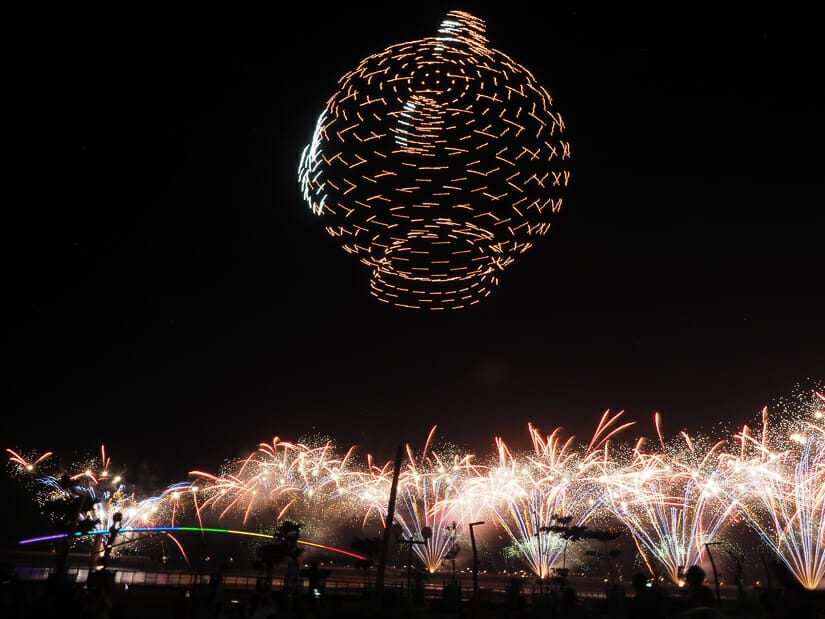
From spring till summer every year (in 2024 it will be from May 2 to July 30), the Penghu International Fireworks Festival draws major crowds.
When we saw the fireworks in 2022, the display was about 50% lit up drones (an increasing trend for such events in Taiwan) and 50% fireworks. Oh, and it was sponsored by Taiwan’s famous and universally used LINE app, hence the bear in the photo that any LINE user will be familiar with.
The fireworks and drones display takes place every Monday and Thursday (May and June) and every Tuesday (July) at 9 PM above Guanyinting Recreation Area and Rainbow Bridge in Magong. There are also some additional Saturday shows (June 1, June 15, July 28) at different locations in the Penghu archipelago.
Island Hopping by Scooter
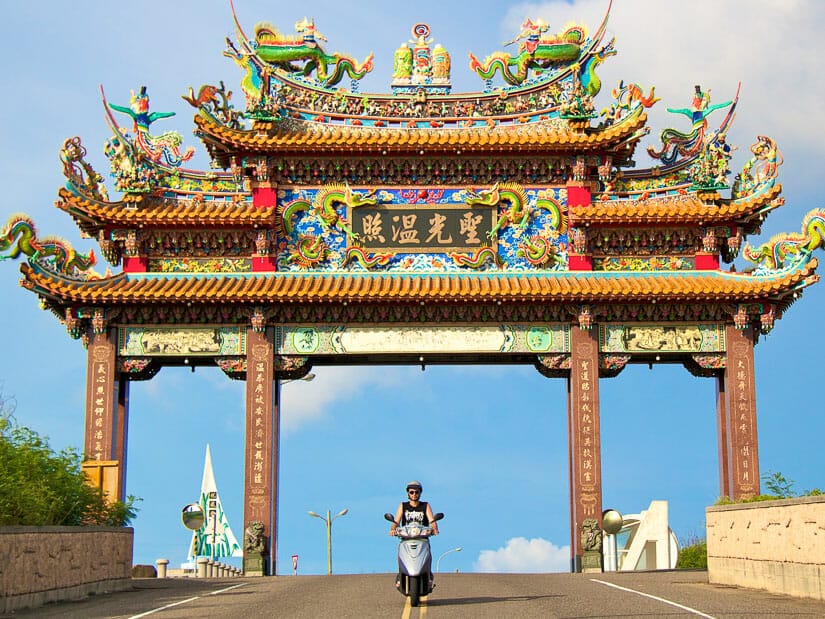
My favorite thing to do in Penghu is to just hop on a scooter and explore the four main islands, which are all connected by bridges. If your package deal (like this one) doesn’t already include a scooter, you can rent one here. An IDP or Taiwanese license is required. You can also rent a car on Penghu, which is a good way to stay out of the sun.
If you have two or more days in Penghu, I recommend spending at least one day touring the main islands by scooter or car, and spending your other day doing a boat island-hopping tour (see next entry) or other activities. If you don’t have a license, you can go by private tour like this one or this one.
I’ll cover all the places to visit on your driving tour in the “things to do in Penghu” section below.
Island Hopping Boat Tours
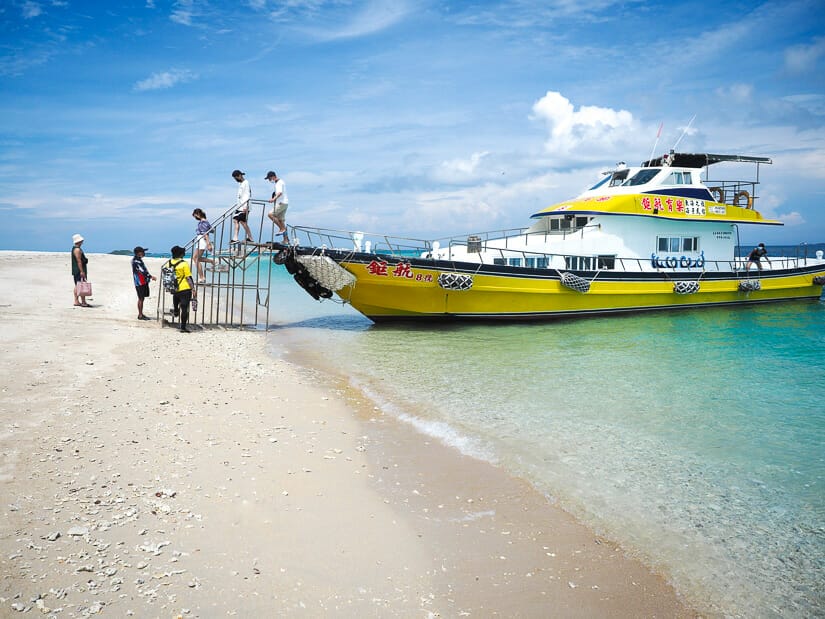
If you want to visit some of the smaller islands in the archipelago, which include some of the most beautiful beaches in all of Taiwan, you’ll need to join an island hopping boat tour. These are generally full-day tours that include several stops and activities.
These tours vary quite a bit. Some like this one take you directly to one or more, where you rent a scooter and drive around on your own. Some like this one include activities like snorkelling at so-called “secret/paradise” locations. And some like this one include thrilling Taiwanese beach activities like getting pulled around on a “banana boat”, jet skiing (no, they won’t let you drive), and jumping off a platform or sliding down a slide into the sea (yes, you’ll have to wear a life jacket). Nighttime squid fishing tours are also popular among locals
Any hotel in Penghu can arrange you a spot on one of these tours. It’s a good idea to find out exactly what the tour includes and make sure that’s what you want. For those who get seasick, bring medication. And if you’re visiting when it’s really hot (which is most of the time in Penghu), these tours can be a long and tiring day.
I’ll be describing all of these tours and where they go in more detail in the “outer islands” section at the end of the article.
Snorkelling and other Water Activities

While some of the island hopping tours include snorkelling, the quality is not great. If you’ve never tried snorkelling before, it would be a good introduction to the activity. But if you have done it elsewhere, you may be disappointed.
On this snorkeling tour, you can mail a postcard from an underwater mailbox (actually, the instructor will do it for you, because it’s deep underwater). This one is also best for beginners.
This snorkelling and sightseeing tour includes one of the best snorkelling sites in Penghu, the so-called “Lavender Forest”. This one is NOT disappointing, but it still won’t compare if you’ve ever been snorkelling in, say, Australia or Indonesia.
Other water-based activities in Penghu include SUP, sailing, kayaking, and this overnight small island camping trip with snorkeling.

Places to Visit in Penghu
Starting in Magong, we’ll then travel out of the city around Huxi Island (the “main island” where Magong is located, then to the three other main islands: Zhongtun, Baisha, and Xiyu, which are connected by bridges.
In the final section below, I’ll cover places to visit on the smaller islands of Penghu, which can only be reached by boat.
Things to do in Magong
Magong is the capital city of Penghu and most of the county’s hotels and restaurants are situated there. Even if you aren’t staying in Magong, there are several worthwhile things to see and do there.
Penghu Tianhou Temple
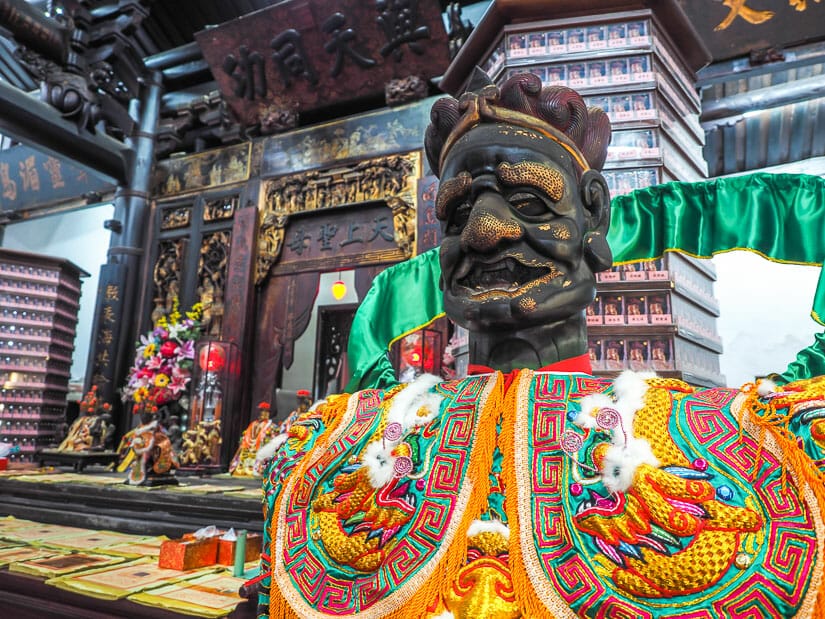
Penghu Tianhou Temple (澎湖天后宮), also called Magong Mazu Temple, is widely considered Taiwan’s oldest temple. It likely dates to the 1400s, but was rebuilt in the 1500s and largely renovated in 1922. The temple is dedication to Matsu (Tianhou), goddess of fisherman and the sea. “Ma Temple” is the origin of the city’s name, “Magong”, and the city was built up around the temple.
The temple is free to enter and has a front, middle, and back section. There is protective scaffolding over part of the temple. The small lanes near the temple (see next entry) are worth exploring.
Zhongyang Old Street

The neighborhood around Magong Temple is the most atmospheric in the city. From the courtyard in front of Tianhou Temple, a narrow alley leads to Zhongyang Old Street (馬公中央老街), the most beautifully preserved lane.
The atmosphere is a bit touristy, but the lane is undeniably picturesque. Follow the lane to Four Eyed Well (四眼井), a centuries-old well with four distinctively round holes for collecting water. Near the old street, have a look at 舊郵便局, a dark green Japanese-era post office building.

Guanyinting and Rainbow Bridge
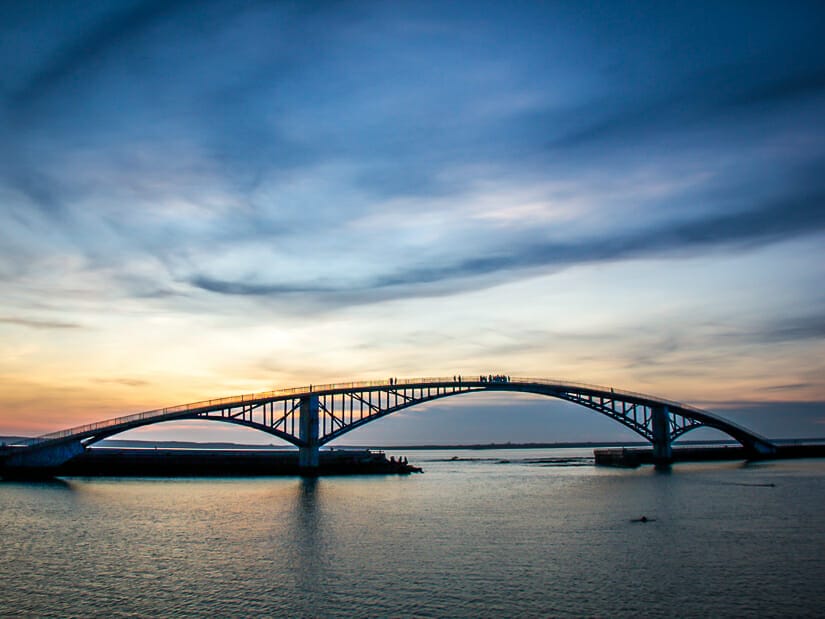
One of the most iconic sights of Penghu is Xiying Rainbow Bridge (西瀛虹橋), a pedestrian-only bridge across a human-made bay on the west side of Magong.
The bay-side area is called Guanyinting (觀音亭親水遊憩區), or Guanyin Pavillion, named after the ancient Guanyin Temple (澎湖觀音亭) there. The temple is famous for its pair of stone lions. The temple was under renovation when we last visited.
This area is the main viewing location of the Penghu International Fireworks festival. It’s also a pleasant spot for a waterside stroll or even a swim. There’s also a large playground for children.

Duxing Ten Villages and Jinguitou Fort
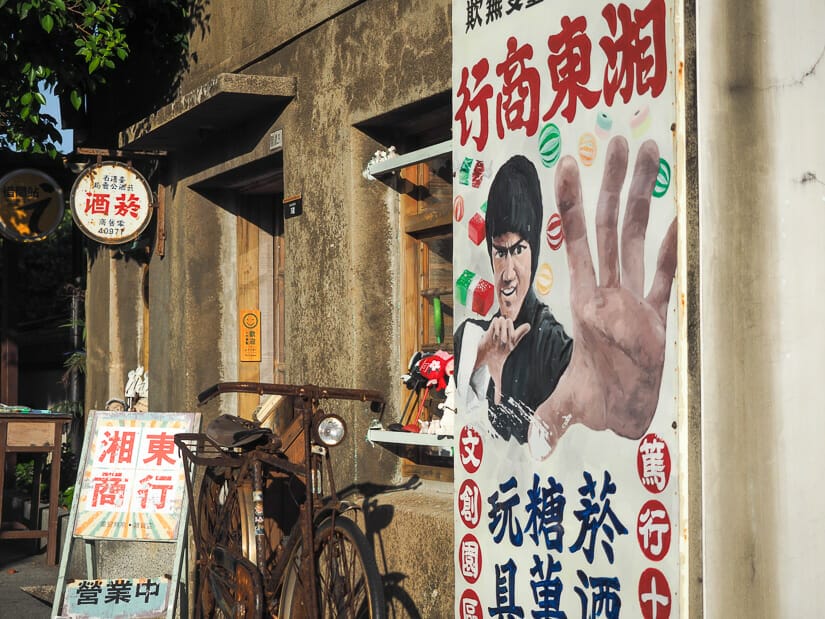
Traveling by scooter, it’s worth driving up to the peninsula just south of Guanyinting. If you’re coming from the south side of Magong, you’ll drive through the impressive Shuncheng Gate (順承門) on the way up.
At the top of the hill is Duxing Ten Villages (篤行十村). This is a collection of old military dorms turned into arts village. There are some cute little cafes and an old fashioned toy train ride for kids. The village also includes Pan An Pang Memorial (潘安邦紀念館), for a Taiwanese singer who was born in the area and died in 2013, and Chang Yu Sheng Memorial (張雨生故事館), also dedicated to a late Taiwanese singer.
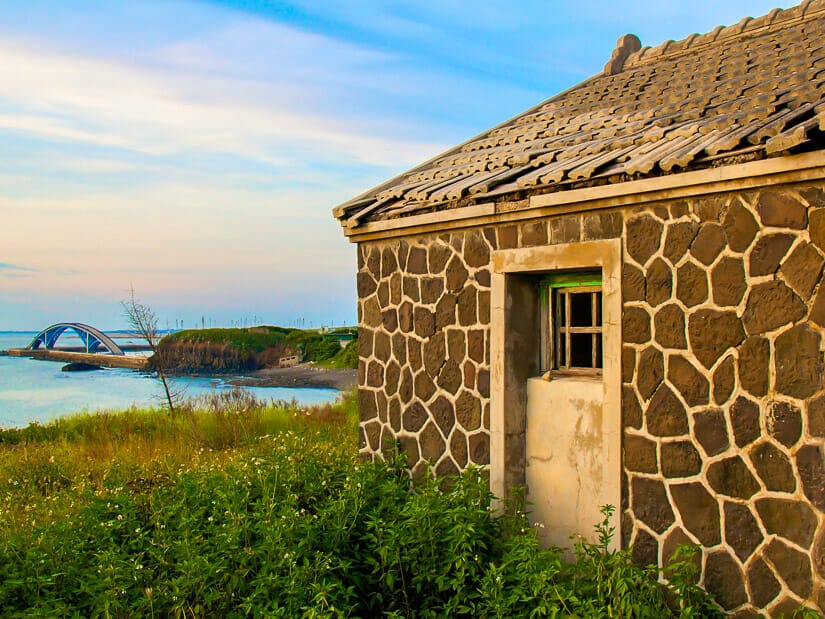
Further up past Duxing, you’ll reach Penghu Juguang New Village (澎湖莒光新村), another collection of military dorms. Most are closed, but you can actually stay in one of them, called 貝富門旅館. You can see Rainbow Bridge and the new giant Penghu Matsu Statue from here, so it’s actually a popular spot for viewing the Penghu International Fireworks display.
Just past Juguang New Village, and at the tip of the peninsula, is Jinguitou Fort (馬公金龜頭砲臺文化園區). The fort has origins going all the way back to the Kingdom of Tungning (1661-1683) and was rebuilt in 1864. It offers good views in all directions, but has limited opening hours (Wed to Sun 9 AM to noon and 2-5 PM, closed Mon, Tues and national holidays).
Magong Harbor

The large Magong Harbor (馬公漁港) is just east of Magon’s city center. Several large, upscale hotels are built around the harbor, including Ya-Ling and Four Points by Sheraton. Inside the Sheraton, the Starbucks Sheraton Penghu (星巴克–澎湖喜來登門市) is considered one of the “special” Starbucks of Taiwan, as it features Penghu and ocean-inspired designs.
Beside the harbor, you will also find Pier 3三號港, which is a modern department store that also contains the Penghu Whisky Museum (昇恆昌Whisky 101威士忌博物館). Penghu Living Museum (澎湖生活博物館), the best museum dedicated to Penghu’s history and culture, is also nearby.
Ferries for the southern small islands of Penghu, including Wang’an and Qimei (where the famous twin heart weir, the cover photo of this article, is located) usually depart from Magong Nanhai Wharf (馬公南海碼頭) in front of Nanhai Visitor’s Center (南海遊客中心).
Last but not least, Penghu Fish Market is the best place to see fresh fish and seafood being sold fresh off the boat in the early morning. It’s also a popular spot for local street cats, as you can see in the below photo.
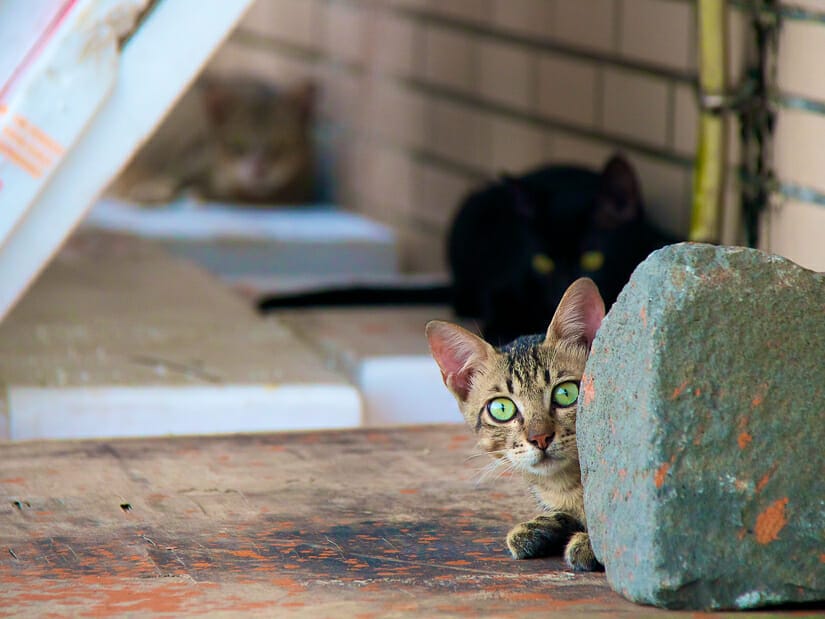
Beichen Public Market

Beichen Market (北辰市場) is the largest local market in Penghu. This is where locals go to purchase fresh produce, seafood, and other foot items. There are also baked items, noodles, soup, and sushi stalls, so it’s a good place to go for a cheap meal.
The market is open all day, but it’s busiest from 8 AM to noon. It is located directly north of Magong Harbor.
Penghu Matsu Statue
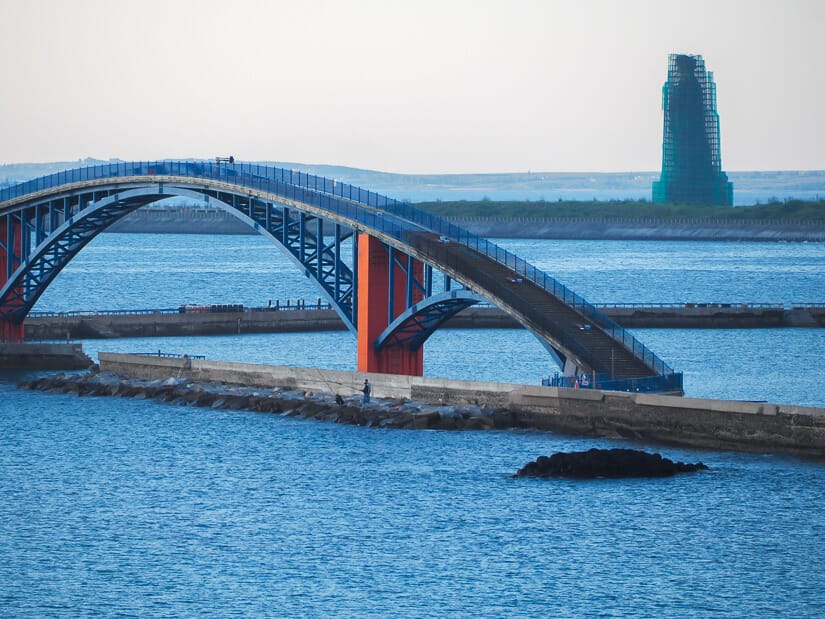
A brand new attraction in Penghu (opened late 2022) is this enormous Matsu Statue (重光媽祖銅像) about 5 minutes’ drive north of Magong. The statue is a whopping 48 meters tall, making it the world’s tallest bronze statue of the goddess.
The statue overlooks the huge bay formed by the four main islands of Penghu. You can also see it from Rainbow Bridge and Jinguitou Fort (where the above photo was shot) to the south. Fun fact: there’re also huge statues of Matsu in Anping, Tainan and on Nangan (Matsu) Island.
What to Eat in Magong
There are four main specialties that Penghu is famous for: seafood, cactus ice cream (仙人掌冰淇淋), pumpkin vermicelli noodles (澎湖金瓜米粉), and brown sugar cake (黑糖糕). Magong is the best place to find these, and has by far the most restaurants and places to eat in the archipelago.
Outside of Magong, we mostly ate or got drinks at 7-Elevens and FamilyMarts!
Seafood
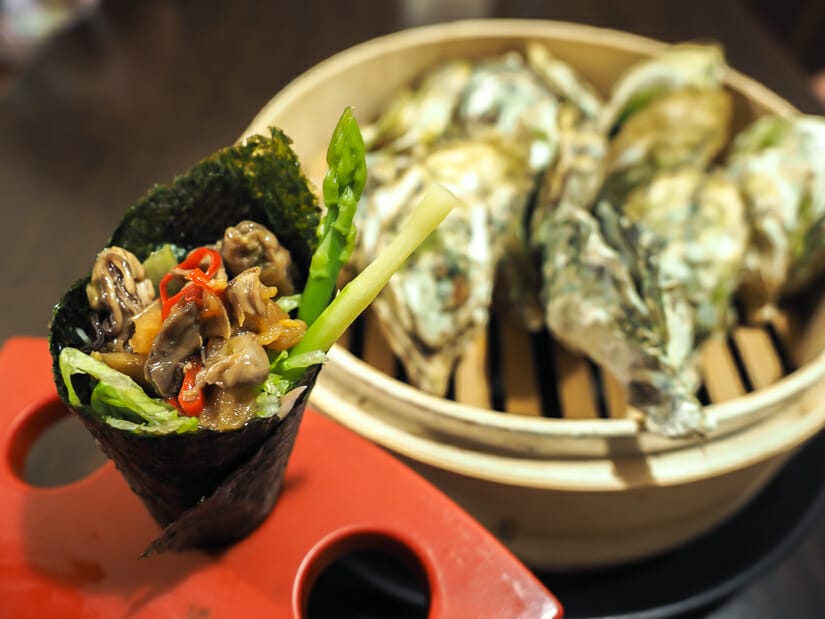
For seafood, there isn’t as much of it in Magong and across Penghu as you would expect. Most of Penghu’s catches are actually sent to the mainland of Taiwan.
The quintessential eating experience that almost every group of Taiwanese visitors does in Penghu is to dine at one of the many open-air DIY BBQ restaurants. If you’re used to Taipei-style BBQ joints, this will definitely be a few steps less classy. 澎湖大姐自助碳烤廣場 is one of several on the main road near Guanyinting.
Blessed Oyster Restaurant (福牡蠣屋) in town has every oyster dish you can imagine. This includes steamed oysters, oyster noodles, oyster sushi, deep fried oysters, oyster omelets, and more.
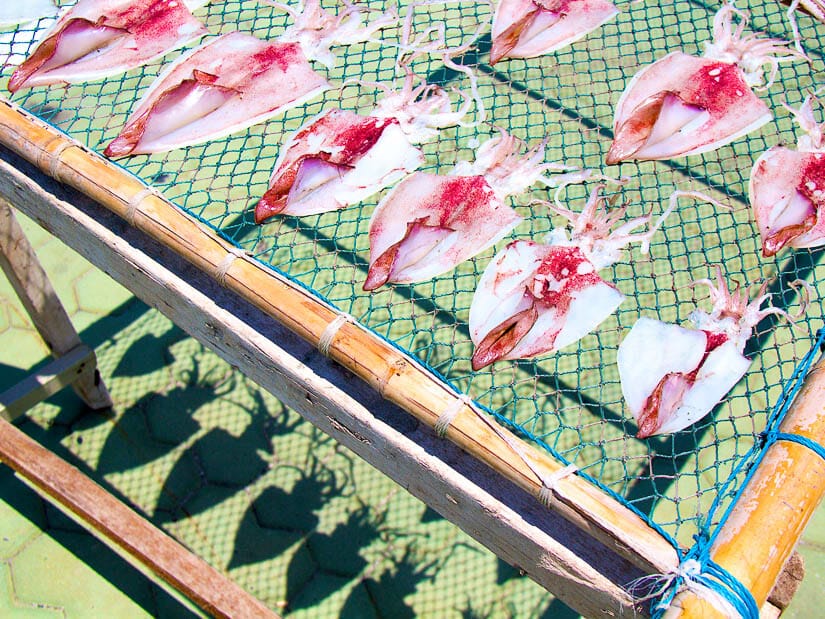
For quick fry style dining (more suitable for groups), there are a few popular seafood restaurants on Magong harbor, such as 臨海樓海鮮料理 and 華珍活海鮮 and 澎漁宴生猛海鮮.
If you’re looking for a quirky experience, 阿家生蠔 on the coast five minutes’ drive north of Magong is a one-grandpa show that claims to be open 24 hrs (he’ll wake up at any time of day or night if you book him). He does fresh oysters, shrimp, and sea urchin. Seating is plastic chairs on top of a rubble-strewn parking lot, and every Taiwanese reviewer mentions that he is funny/crazy.
Cactus Ice Cream and Other Treats
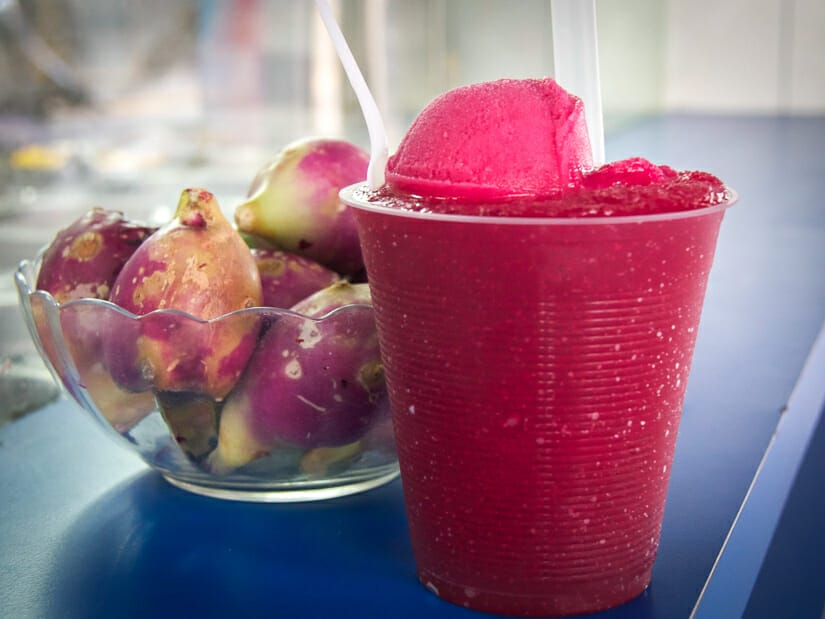
Penghu’s famous cactus shaved ice and cactus ice cream are made from the native Penghu elephant ear prickly pear (澎湖紅蘋果仙人掌, usually just abbreviated to xianrenzhang or 仙人掌). The cacti are small and vibrantly purple on the inside.
Penghue Cactus Ice City (澎湖仙人掌冰城) For a no-frills cup of cactus slushy topped with cactus ice cream, I recommend this corner shop in Beichen Temple Night Market. The shop also has some special herbal drinks like aloe jelly with honey (蜂蜜蘆薈) and chilled fengru tea (野生風茹茶), made with a medicinal herb found only in Penghu.
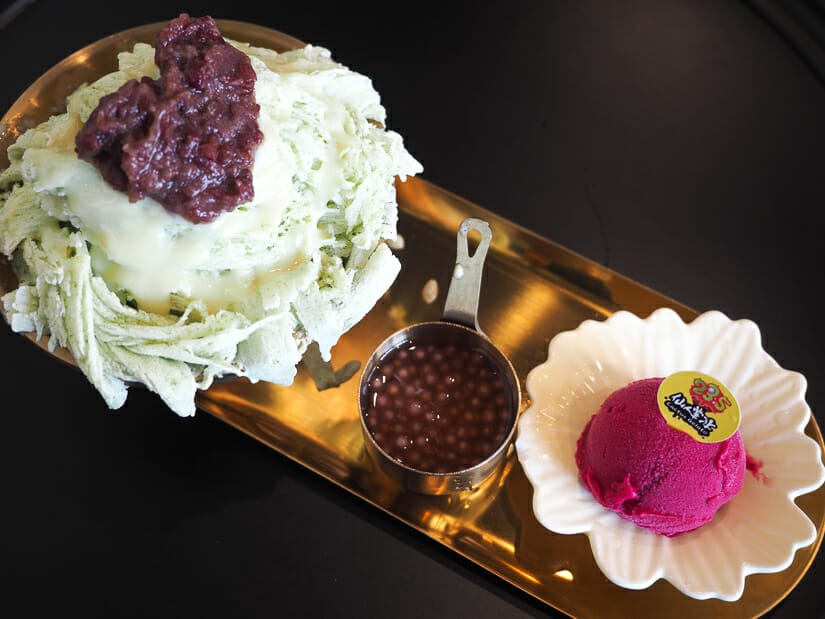
23.5° Cactus Ice Cream (235掌上明珠仙人掌冰淇淋) does a pimped up version of cactus ice cream, including cactus flavored pearls, seaweed flavored shaved ice, cactus ice cream floats, and more (see photo above). It’s at the far south end of town, but has limited hours.
Chinese Mesona (玉冠嫩仙草) is an iced dessert shop that is incredibly popular among Taiwanese visitors. They don’t do cactus but rather shaved ice with traditional toppings, including black mesona (grass jelly). It is near Magong Harbor.
If you’re looking for a fancy cocktail, including cactus margaritas or giant cocktail bowls for groups, Sunla is a short drive north of Magong. The vibe is pretentious and we were turned away without a reservation, even though every table in the place was empty. It’s pricey.
Pumpkin Vermicelli
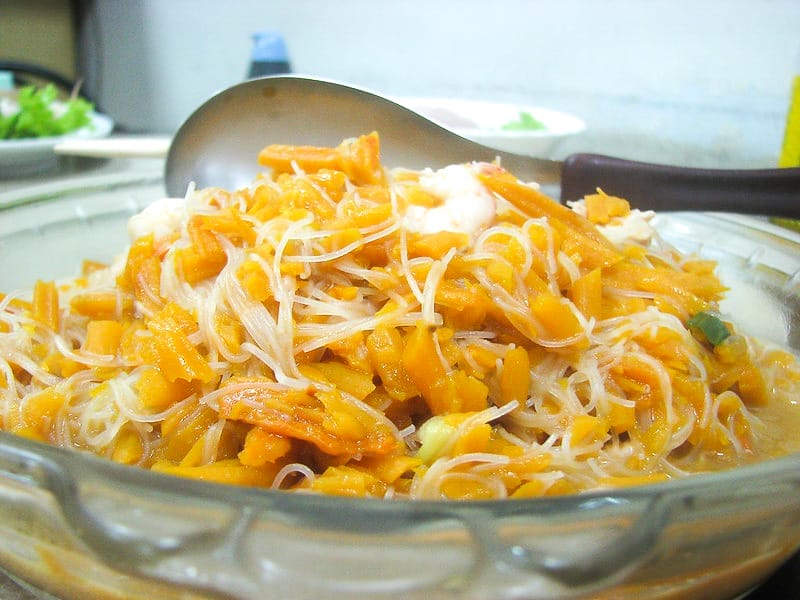
In local noodle shops, you can find vermicelli noodles served with steamed pumpkin (金瓜米粉). Healthy! Just plug the Mandarin name of the fish into GoogleMaps and you can find half a dozen small shops in town serving it.
Brown Sugar Cake
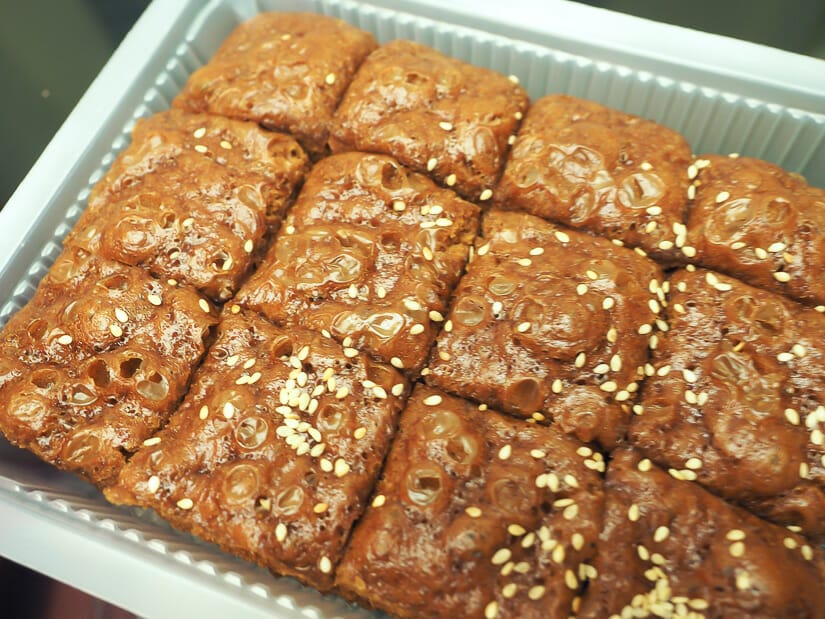
Every destination in Taiwan has its own local “famous” snack or specialty to take home. In Penghu, that would be brown sugar cake (黑糖糕 or heitang gao). It has a chewy texture and is very similar to the brown sugar cake you can find in Hakka communities in northern Taiwan.
After some research before our trip, my Taiwanese sister-in-law concluded that 三岳黑糖糕 has the best brown sugar cake in Penghu.
盛興製餅舖 in Beichen Temple Night market is a more popular and convenient place to buy it. You can also find it in shops around Tianhou Temple.
Penghu Night Markets in Magong
Sadly both of Magong’s night markets are basically dead. Wenao Zushi Temple Night Market (文澳祖師廟幸福小夜市) used to be the largest, but there’s almost nothing left of it.
Beichen Temple Night Market (北辰宮夜市), which I’ve mentioned a few times above, is hardly better. It’s just a normal street with some restaurants, teashops, and only a few food stalls that can’t even keep up with the demand. When we tried to order sticks of BBQ items from one stall, the stall owner said the wait was 45 minutes!
In other words, don’t have any high hopes for night markets in Penghu. Instead, save you night market hopping for these ones in Kaohsiung, Tainan, Taichung, or Taipei.
Things to do around Huxi Island
Huxi Island (湖西島) is the largest of the main islands of Penghu. Magong is located at the island’s western end, while the airport is roughly in the middle of the island.
Penghu’s most popular beaches are on the island, along with several other sights worth visiting. I recommend spending one of your days in Penghu touring these sights on Huxi Island and the other three main islands (see the following section below), ideally by car, scooter, or private tour.
Aimen Beach

Aimen Beach (隘門沙灘, literally “Narrow Beach”, although it is quite wide) is the most popular beach in Penghu. It’s an expansive stretch of golden-white sand with designated swimming areas. The beach is close to the Penghu Airport and is about 15 minutes by scooter from Magong.
A lot of watersports are done here, including the ubiquitous banana boats that every Taiwanese is familiar with, as well as jet skiing, kayaking, offshore water play parks, and more. Music is pumped out from the food stand. If you’re looking for a quiet beach to yourself, avoid this one.
If you need beer, pick it up from the 7-11 on the main highway on your way to the beach.

Just past Aimen, Lintou Beach (林投金沙灘) is a quieter alternative to Aimen Beach. Between the highway and Lintou Beach, I recommend a food stall called Lintou Park Fried Fish (林投公園炸魚).
Hidden away around a corner, the auntie here serves traditional deep fried rice cakes, yam, fish, oyster balls with fresh shrimp, and more. It was one of our best finds on Penghu.

Shanshui Beach

Shanshui Beach (山水沙灘) is a good alternative to Magong, for anyone looking to stay in a small seaside village rather than the city. The long, golden sand beach is decent for swimming, but it does get deep rather quickly. It is less busy that Aimen and there’s no bumpin’ music here.
You can also walk up to Shanshui 30 Park (山水30公園) via some coastal caves (山水吼洞). The Garden Tapas and Bar (菜宅裡的小酒館) in town has been recommended to us by friends, and we’ve dined at 澎湖山水夏日, one of the DIY BBQ places along the main road just off the beach.

Near Shanshui Beach, in the village of Suogang, there are two large stone towers (石塔). These were traditionally built all over Penghu to ward off bad spirits. The pair in Suogang are the largest in Penghu.
They are marked 鎖港南鎮風塔 and 鎖港北石塔 on GoogleMaps, and I marked them on the Penghu map I created above.

Shili Beach & Fongguei Cave
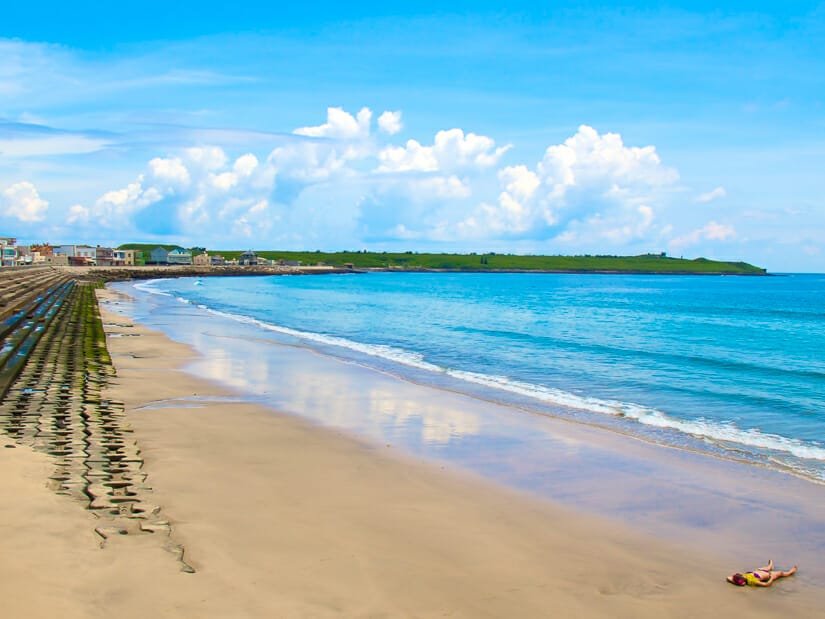
Further west down the coast from Shanshui Beach, Shili Beach (嵵裡沙灘) is truly remote. The beach is smaller and almost non-existent at high tide. When my sister and I visited Penghu, we spent a whole afternoon on this beach and never saw another soul.
From Shili Beach, you can continue to the end of the island to visit Fongguei Cave (風櫃洞 or Feng Gui Cave), which is known for making whistling sound when wind blows through it.
Kuibishan and Moses Divides the Sea

It’s a bit of drive, but at the opposite end of Huxi Island from Magong, Kuibishan (奎壁山) had become all the rage for Taiwanese visitors to Penghu. They come to see the dramatically named “Moses Parts the Sea” (摩西分海) phenomenon.
Every day at high tide, a sand bar leading out to Chi Yu (赤嶼 or Chi Island) gets exposed. If you time it right, you can see the sand bar gradually shrink into a winding path from the shore to the island. We DIDN’T time it well, so when we got there, the sand bar was very wide and didn’t look like anything special. We came back later, and saw what you see in the above photo – still not as cool as when it gets even narrower and then disappears.
I wish we had known about this table showing the exact times that the sea will separate (分海) to expose the trail and come back together again (合海) to make the trail disappear. For the former, you’d want to stick around after that time to watch it get bigger. For the latter, you’d want to come a good 30 min to 1 hr before so you don’t miss it and so you have time to walk out on it before they begin stopping people.
Things to Do on the Other Main Islands
From the northern end of Huxi Island, a bridge crosses to small Zhongtun Island (中屯島) which has little more to see than a collection of towering Wind Turbines (中屯風車). The road then crosses another bridge to much larger Baisha Island (白沙島 or White Sand Island).
Heading north and then west, Baisha Island connects to Xiyu Island (西嶼) via Penghu Great Bridge, the longest bridge in all of Taiwan.
Baoding Temple, Baisha
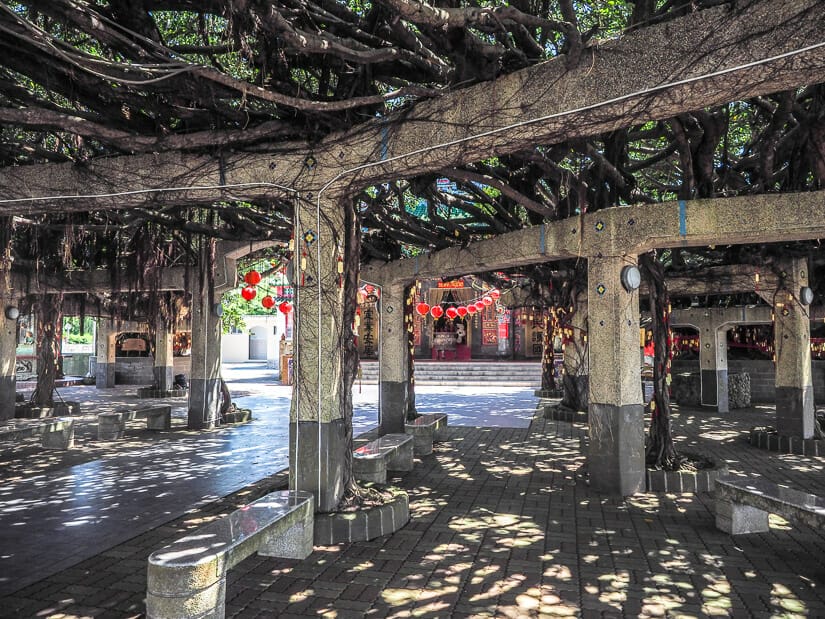
Baoding Temple (保定宮) is a smaller version of the larger Tongliang Great Banyan (see below). It is a temple whose courtyard has been covered with a canopy formed by the roots of a large banyan tree.
It’s right at the turnoff for Penghu Aquarium, so you can’t miss it.
Penghu Aquarium, Baisha
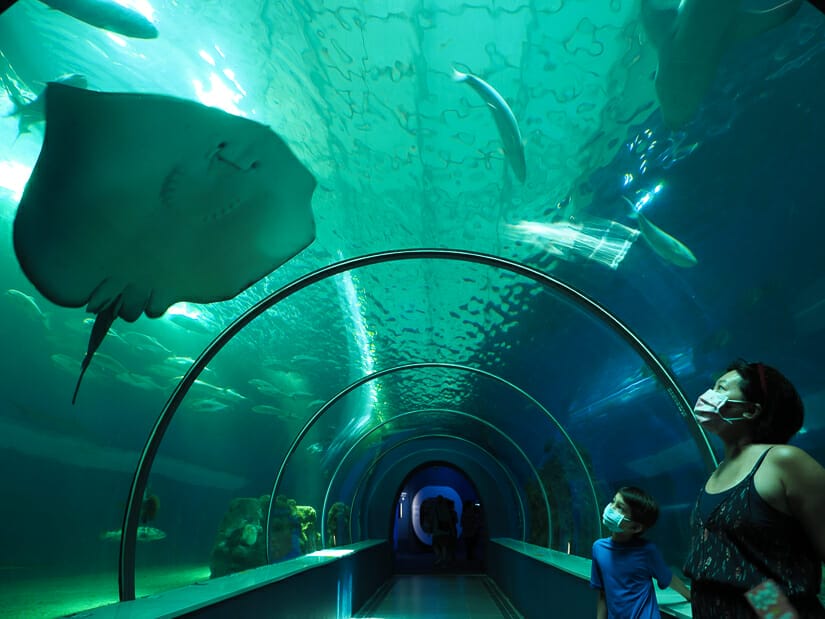
We took our kids to Penghu Aquarium (澎湖水族館) with no expectations, but were pleasantly surprised. We spent a good couple hours inside (a great escape from the relentless sun!) marvelling at marine creatures, including horseshoe and spider crabs, moray eels, cow fish, lion fish, octopi, and more.
There was a treasure hunt for kids, and they were able to touch real starfish. We would recommend a visit!
Just past Penghu Aquarium is Qitou Wharf (岐頭碼頭), where ferries depart for eastern island tours. For ferries to Jibei Island to the north, you’ll have to head up to Chikan Wharf (赤崁碼頭).
Penghu Houliao Paradise Road, Baisha
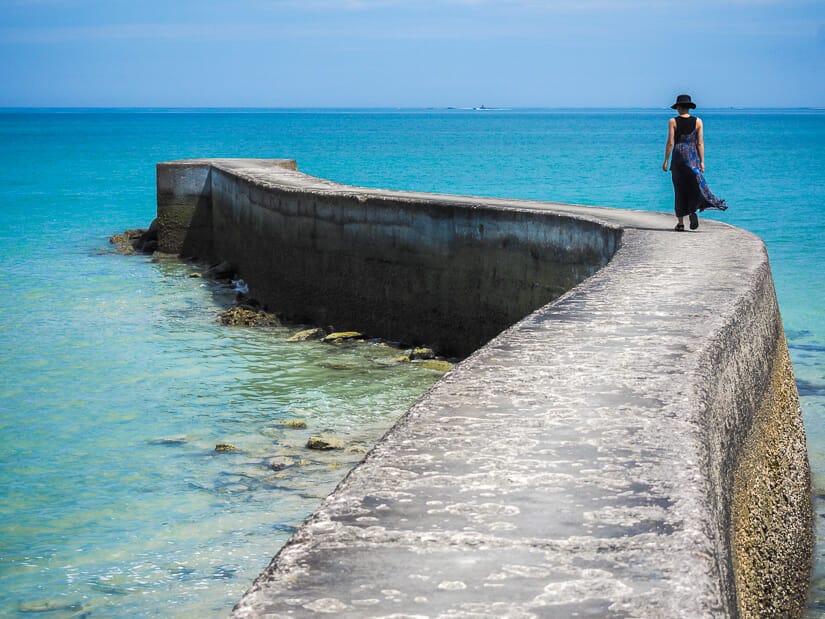
We took a chance on this little attraction we noticed marked on GoogleMaps called Penghu Houliao Paradise Road (澎湖後寮天堂路). Just like “Moses Parts the Sea”, you came here basically to shoot a photo and that’s it, but unlike the Moses one, there’s nobody here.
Basically all that’s here is a long cement dock that winds out into the city. It’s a great photo op, though. We visited at low tide, but at high tide, the water comes right up to or even covers it a little, which could make for even cooler photos.
You have to drive through some very narrow countryside lanes to find it. Scooters aren’t allowed for the final 500 meters or so of the paved trail down to the water, which my kids hated me for (it was an extremely hot day).
Tongliang Great Banyan, Baisha

A truly unique and must-see attraction in Penghu is the Tongliang Great Banyan (通樑古榕). A huge canopy of banyan tree roots has over the years been painstakingly formed over the large courtyard in front of the Taosit Tongliang Bao’an Temple (通梁保安宮).
This is a popular spot, so there are usually souvenir stalls and several shops selling cactus ice cream around the temple.
Penghu Great Bridge
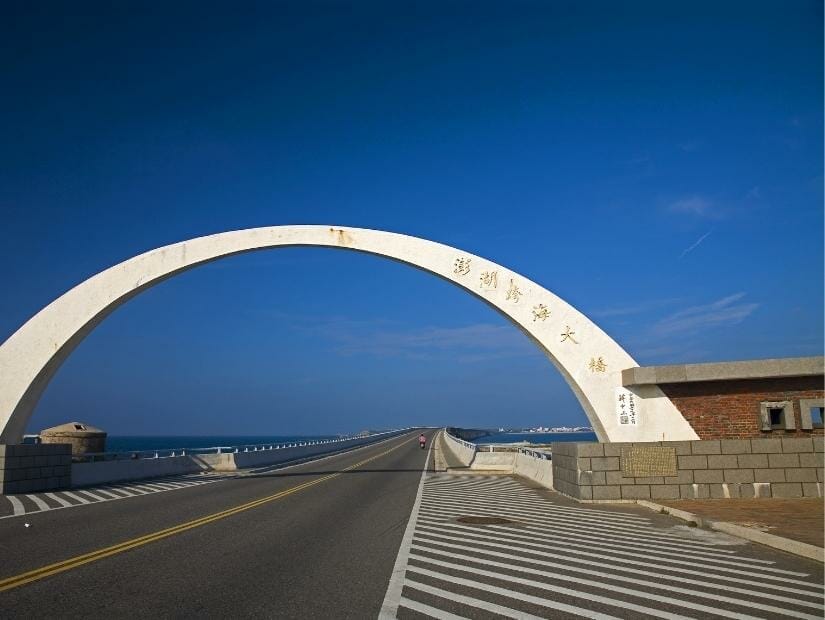
Penhu Great Bridge (澎湖跨海大橋), which connects Baisha and Xiyu islands, is the longest bridge in Taiwan, at 2494 meters.
No Taiwanese dares scootering across the bridge without first stopping to take a mandatory jumping photo in front of the white arch at the bridge’s entrance on the Baisha side. The arch has become a symbol of Penghu.
Xiyu Island Statues

After crossing the Penghu Great Bridge to Xiyu (西嶼 or Xi Island), one of the first things you’ll notice is the abundance of large, colorful, often comical statues on the island.
Yuwengdao Statue (漁翁島銅像), a large fish statue just off the bridge, and Xiyu Landmark, a giant colorful ship (西嶼地標) are even marked on GoogleMaps. We also saw statues of a whale, octopus, fisherman, peanut, and more.
Whale Cave, Shomon Island
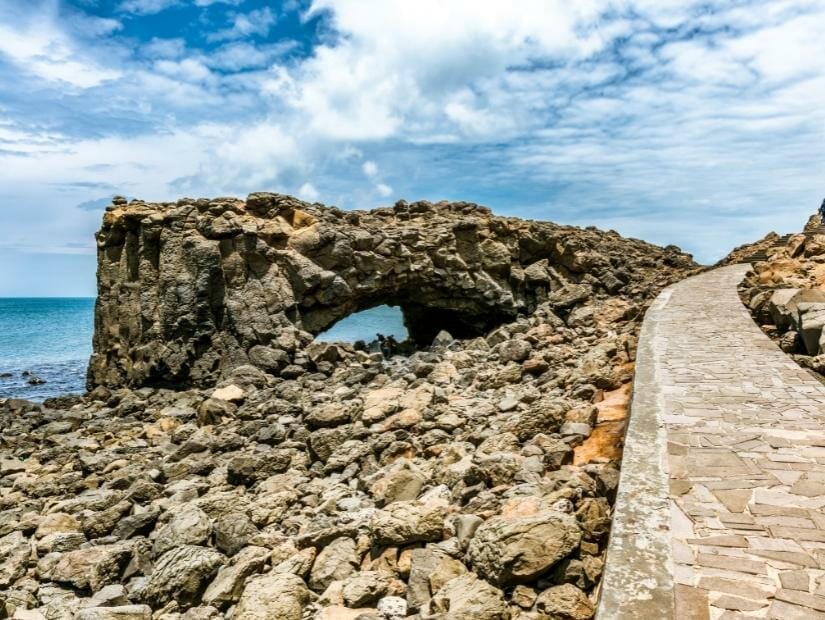
Whale Cave is a coastal cliff that looks like a whale, with an eye hole cut out by crashing waves from the sea. It’s on the northern tip of Xiaomen Islet (小門嶼 or Shomon Island), a small island accessed by a very short bridge from the northern tip of Xiyu.
Seeing it requires a 15-minute (round-trip) drive from the main highway.
Zhuwan Dayi Temple, Xiyu
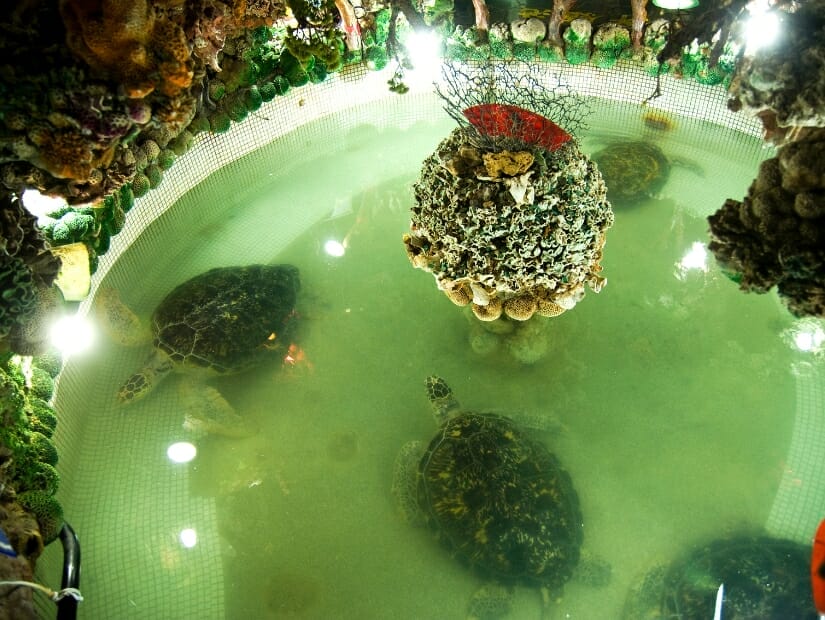
I am so happy to report that Zhuwan Dayi Temple (竹灣大義宮) on Xiyu has finally released its collection of giant sea turtles, which for many years it controversially held captive in a tiny, underground area below the temple.
We were horrified when we first visited this temple years ago. According to recent reviews, the turtles have finally been handed over to the government to be released to the sea. If you visit today, you can see turtle statues out front, and there’s a small crab museum (竹灣螃蟹博物館) next door.
You don’t need to go out of your way for this, but I’m just including it so I can update everyone about this positive outcome to what was once an unethical tourist attraction on Penghu.
Erkan Historic Village

Make sure you leave time in your schedule to make it as far as Erkan Historic Village (二崁聚落保存區). This is one of the most unique places to visit in Penghu and Taiwan, and we really loved it.
Erkan is a small, traditional village built up around the Chen Family Historical House (二崁陳家古厝). But what sets it apart is that the outer walls and even parts of the houses themselves are built with coral and seashells, mainly due to the lack of building materials in Penghu.
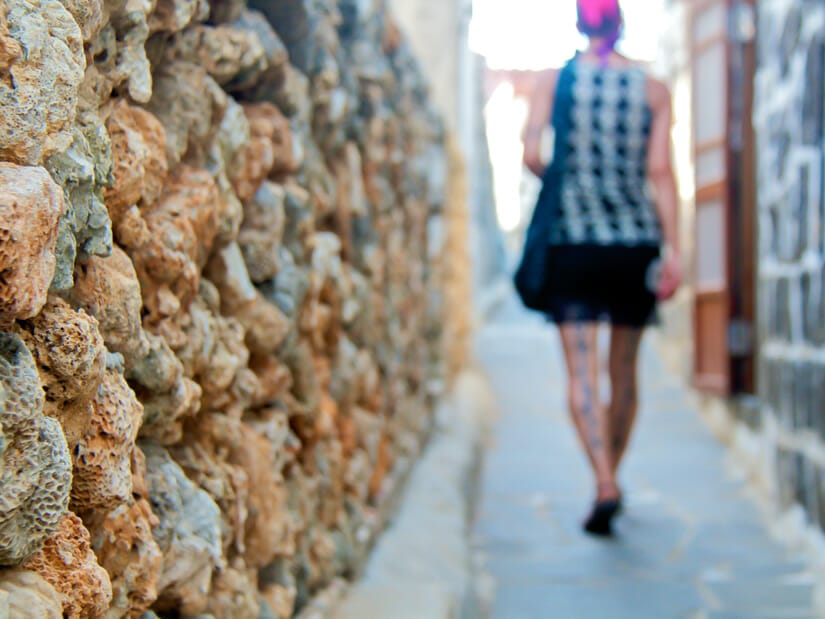
You can actually see coral walls all over Penghu, but Erkan is the best example of them. Houses in the village have been restored and beautified with paintings and other artworks. Some of them house cute little snack and ice cream shops. It’s an incredibly atmospheric and photogenic setting, perfect if you’re looking for a photography location.
At the turnoff on the highway for Erkan Historic Village, 可口冰城 is a traditional drink and ice cream shop, one of the few places you can stop along the highway for a treat that’s NOT 7-Eleven or Family Mart.
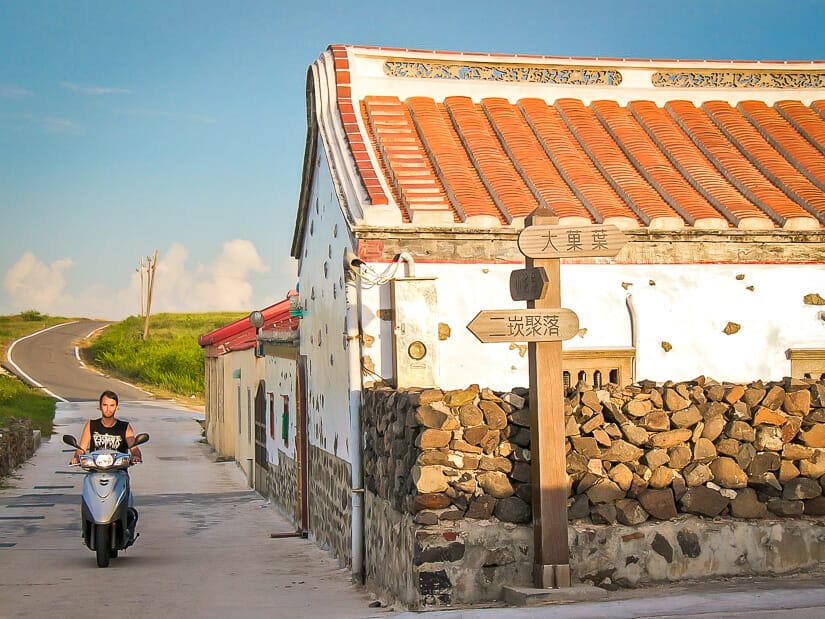
Daguoyue Columnar Basalt
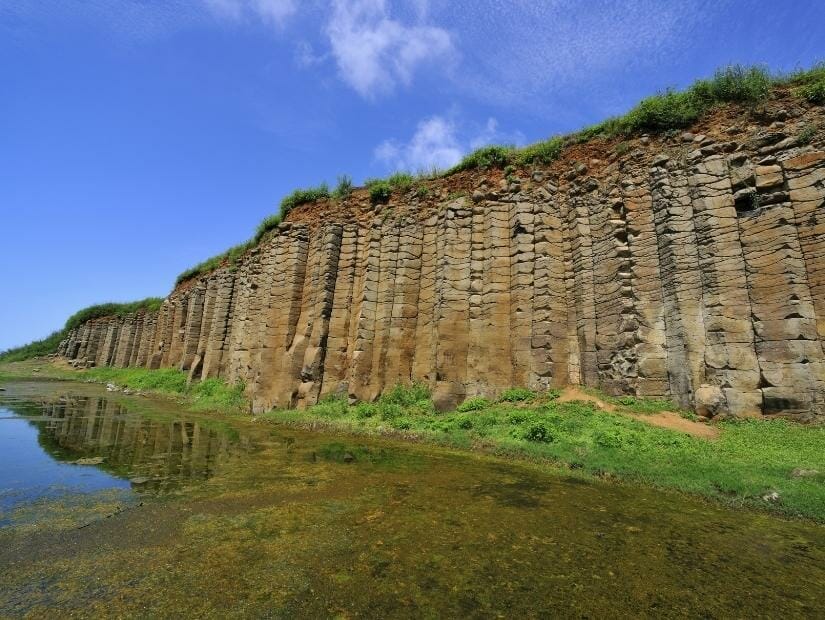
There are several places where you can see Penghu’s basalt columns, some of the most unique natural landmarks in Taiwan. These were formed by a process in which lava rose and then cooled multiple times, forming layers of stone is vertical columns.
Daguoyue Columnar Basalt (池東大菓葉玄武岩) is the most popular spot in Penghu to observe this special geological landmark. A small pond at the base of the columns helps for capturing more interesting photos.
Don’t miss the lesser known Three Stone Walls (三石壁) with similar cliffs beside a pond, just two minutes away. There’s another less visited area of basalt columns further north on the island called Dachi Columnar Basalt (大池火山頸玄武岩), near the aptly named Dream Beach (夢幻沙灘).
You can also expect to see basalt columns on island hopping boar tours, especially to the southern islands.
Chixi Rock Waterfall
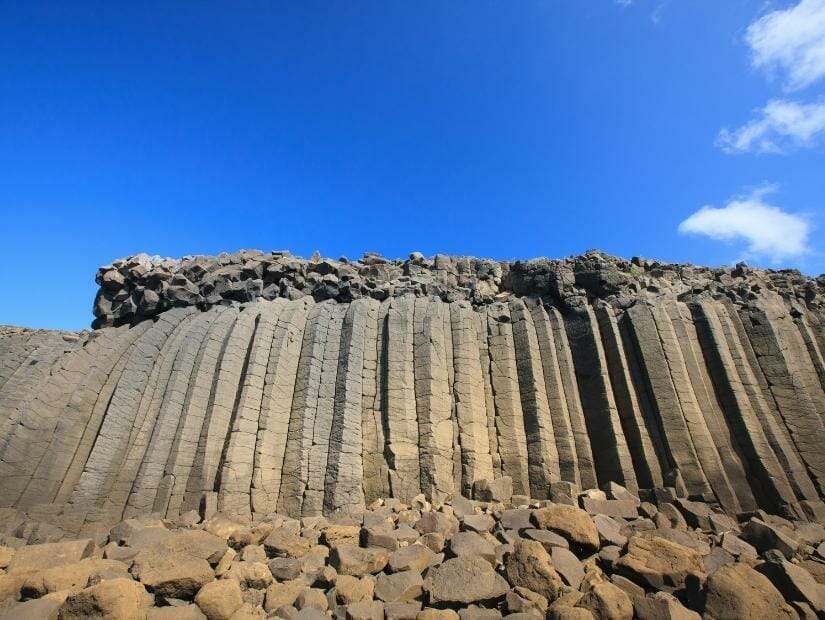
Even more basalt columbs can be seen at Chixi Rock Waterfall (池西岩瀑 / 九孔瀑布), so named because when viewed from the coast below, the columns of stone appear to spill down like a waterfall.
We actually found this site more interesting than Daguoyue because you can also explore the group of stone weirs just off the shore. Unlike the famous heart-shaped weirs, these are rectangular in shape. You can walk ride on them when the tide is low enough and peer at the fish trapped inside.
Chixi Tiger Eye Weir

On our most recent trip, we were excited to find this smaller version of the famous Twin Hearts Stone Weir on Qimei Island, which I had been to before but my companions wouldn’t have a chance to visit.
In this case, the weir is just shaped like a single heart or, according to the name (池西虎目滬), a tiger’s eye (?) Anyway, this one is really cool because, unlike the much more famous twin hearts on Qimei, which you view from a cliff far above, this one you can actually walk on and see all the fish inside.
The weir is located on the western side of a bay just below Chixi Rock Waterfall. The bay also has a nice beach that usually has nobody on it.
Yuwengdao Lighthouse
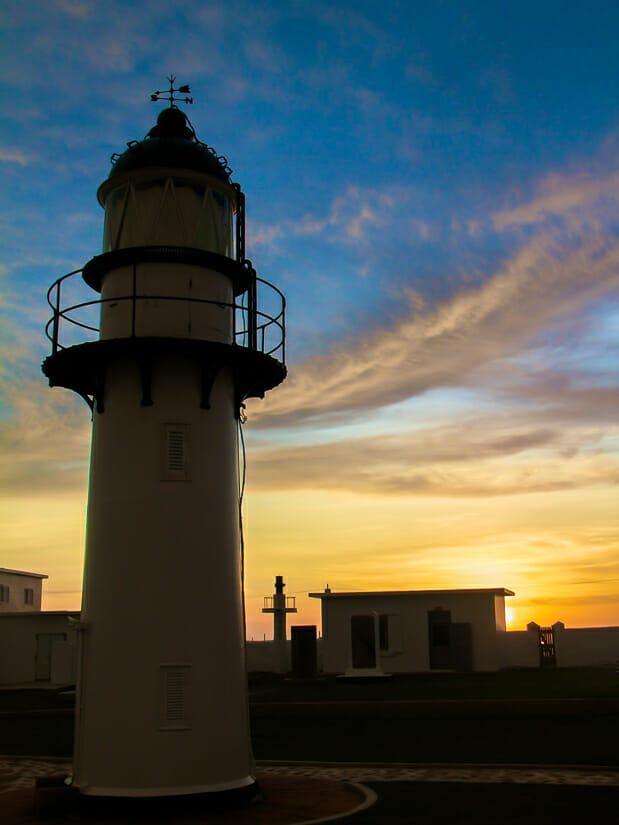
If you’ve made it this far on Xiyu, you might want to consider going all the way to the end. Yuwengdao Lighthouse / Xiyu Lighthouse (漁翁島燈塔 / 西嶼燈塔) is a small lighthouse on a military base on the southwestern tip of Xiyu.
This is the westernmost point on the main islands of Penghu, and the furthest away from Magong you can get by scooter/car. We recommend coming here for sunset at the end of your day tour, like we did. But please keep in mind that it will be a long drive, mostly in the dark, all the way back to Magong. Budget about an hour to drive back by scooter.
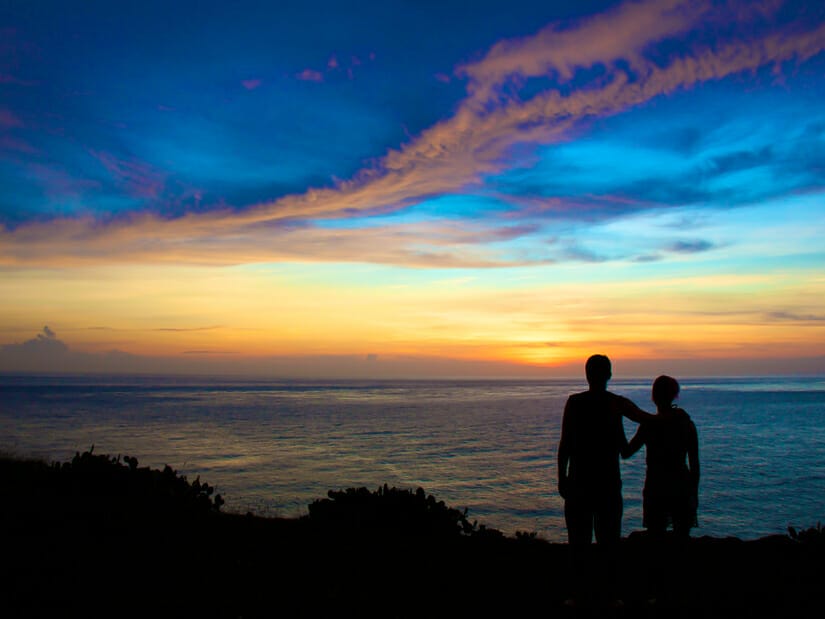
Things to Do on the Outer Islands
With nearly 100 islands in total, there are all kinds of small island-hopping tours available from Penghu. You can pre-book them via the links below, or any hotel can arrange one for you (you’ll need to ask lots of questions to get the full itinerary).
I must warn any readers who are from Western countries or who have traveled a lot or done lots of water activities before. If your tour includes any water sports, be prepared to be treated like a child. You must wear a life jacket for snorkeling or jumping into the ocean, even if you don’t need it. You must wear a lifejacket and helmet (no idea why…) for getting pulled around on the banana boats. Expect many rules like this.
You’ll need to exercise some patience and keep in mind that many Taiwanese can’t swim or haven’t done these kinds of things before, so the tour operators have to take many precautions. Some tours also include some unusual (or environmentally questionable) activities – see the Eastern Island tours section below.
Most of the Penghu Island hopping tours fall under the three below categories.
Southern Islands Tour
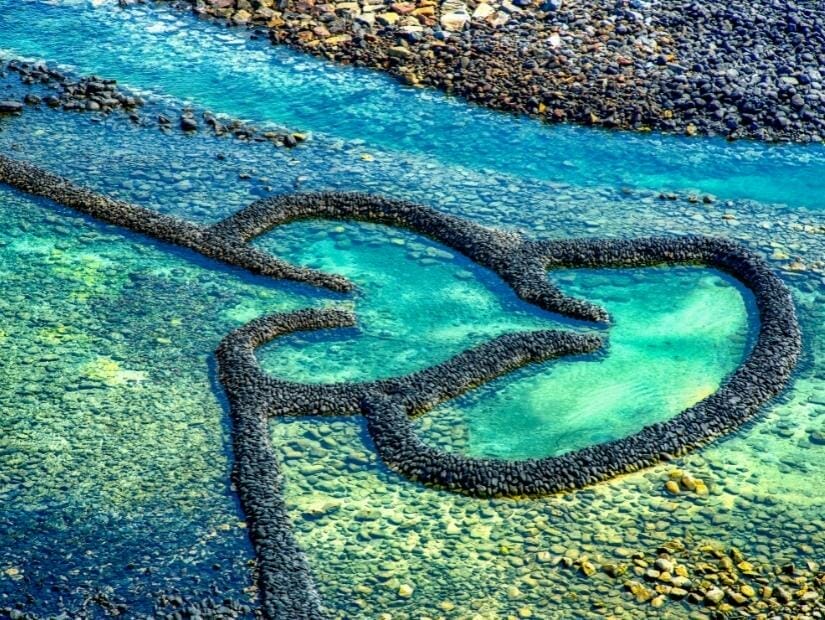
If you’re looking for a tour where you just go directly to islands for sightseeing on your own (with minimal watersports and other frills), I recommend a southern islands tour. However, the time on the boat is the longest of the three categories, so it can be rough for those who experience seasickness. It can be a long, hot day on the boat.
These tours usually depart from Magong Nanhai Wharf (馬公南海碼頭) in Magong Harbor, so these are most convenient if you don’t have a scooter/car.
Almost all of them include Qimei Island (sometimes spelled Chimei), where you can ride a scooter or bus to see the famous Twin Hearts Stone Weir (七美雙心石滬), perhaps the most recognizable and iconic sight in all of Penghu, as well as Little Taiwan (小台灣), a flat rock shelf that looks like the shape of Taiwan from above. Note that there may be an extra fee for the bus or scooter rental.
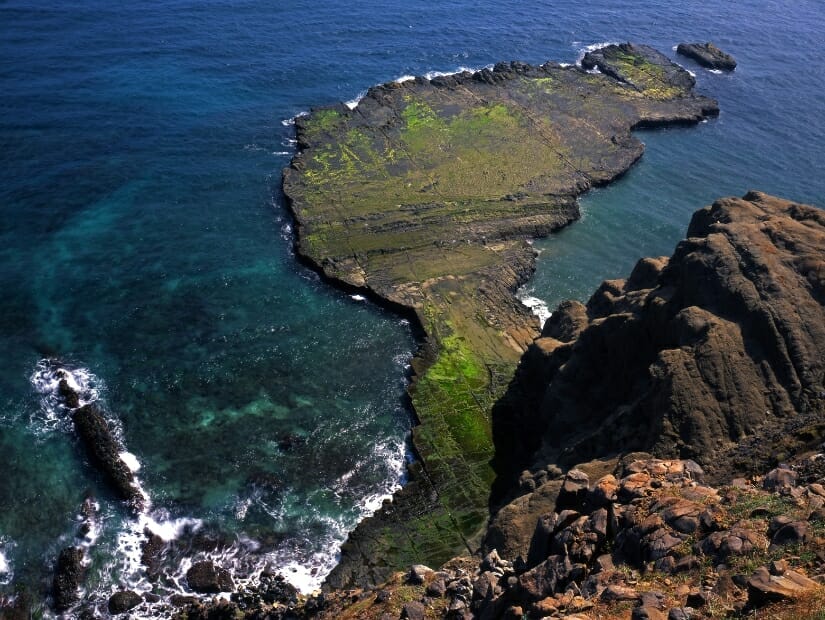
This boat tour ONLY goes to Qimei, with the option to add snorkeling or kayaking. This boat tour includes Qimei, Blue Cave (北岸海蝕洞) on Xiji Island (西吉嶼), and a stop on Dongji Island (東吉嶼). If you prefer to just go it alone, this deal includes a ferry ride to Wang’an or Qimei plus scooter rental when you get there.
Most tours include driving past basalt columns at Tongpan Geology Park (桶盤地質公園) and similar ones (虎井澄淵) on Hujing Island (虎井嶼), also called Table Island. Some, like this one, actually stop on this island, which is nicknamed “Cat Island” for its many cats. It has also a famous white statue of two hands. But this tour does NOT go to the famous Twin Hearts Stone Weir on Qimei.

Other tours stop at Wang’an Island (望安島), which is the fourth largest island in Penghu and has several smaller points of interest.
Island hopping tours like this one, this one and this one include snorkeling in the “Lavender Forest” (薰衣草森林), which is just an exaggerated name for a spot that has lots of purple coral near Dongyuping Island (東嶼坪嶼). It is, however, one of the best snorkelling spots in Penghu.
This overnight tour includes camping on Jinguazi Reef (金瓜仔礁), which is a tiny island off Wang’an, and which in local tour descriptions is always called Wangyou Island or “Forget your worries island” (忘憂島), a name the tour companies made up. They always say it is a “secret” location and don’t mention the island’s real name (Jingauzi). Sorry if I spoiled it!
Eastern Islands Tour
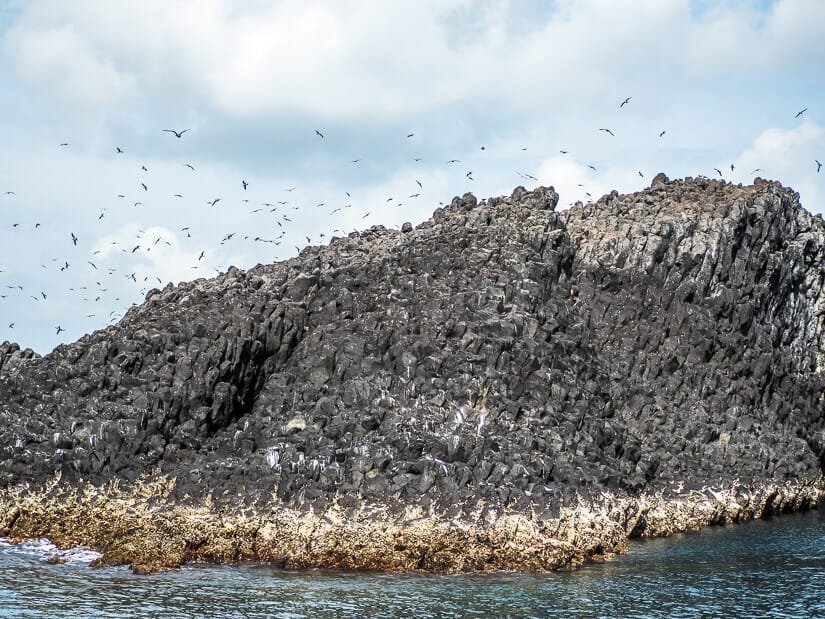
A collection of small islands lie to the east of Penghu and are accessed by ferry from Qitou Wharf (岐頭碼頭) on Baisha Island. You’ll need to get to the wharf by yourself for these tours – budget at least 20 minutes to get there by scooter from Magong. I recommend these tours for people who like more activities.
When we did a tour essentially the same as this one or this one, I found that that the day was unnecessarily long, with lots of time spent waiting around. There was even a designated nap time after lunch (totally common in Taiwan, even for adults).
The tour also had some bizarre/questionable activities, like throwing pieces of raw fish up in the air from the boat for seagulls to catch in the sky. We sailed past a few basalt cliffs and islets inhabited by birds, then stopped at Bird Island (鳥嶼 or Niaoyu, also called Cho Island) for lunch and snorkelling.
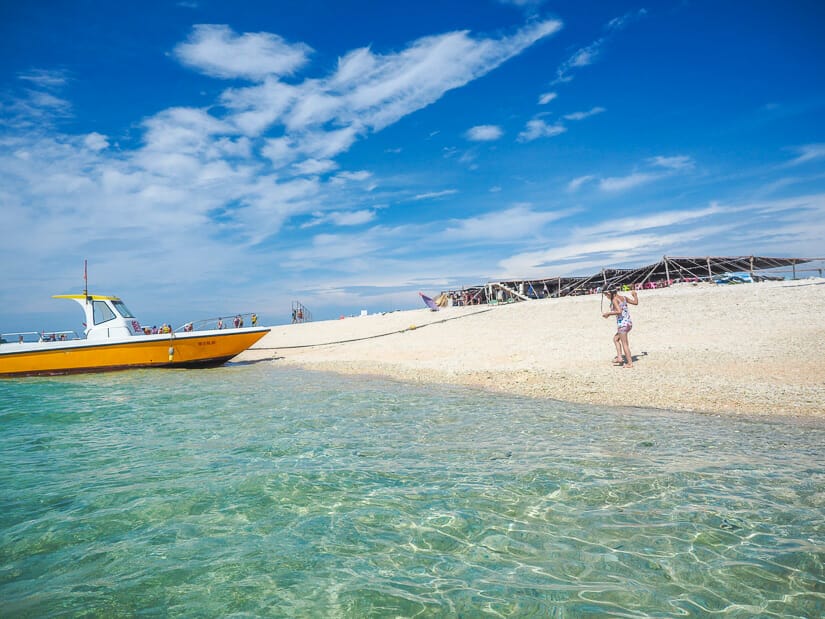
After snorkelling (which was mediocre quality), we went “wildlife watching”, which consisted of them showing us several sea creatures they’d captured and placed in a shallow pool for tourists to look at. The guide even picked the sea creatures up out of the water with his hands for people to photograph.
So why did I take this tour? Well, I badly wanted to visit Peng Peng Beach (澎澎灘), which is a tiny island consisting of a long strip of white sand that supposed just appeared out of the ocean one day after a typhoon. You can see it from the mainland around Qitou Wharf, and I had wanted to go ever since I saw it on a previous trip to Penghu, when I shot the below photo of it from afar.
Peng Peng Island was as beautiful as I’d imagined. We spend about 2 hours there, as this is where they did several water activities, like banana boats, waterslide, and jumping into the ocean from a floating platform. There was a large sitting area with a large canopy (crucial because it was brutally hot) and drinks for sale.

Northern Islands Tour

To the north of Penghu’s main islands lies Jibei Island (吉貝嶼, which also means Bird Island) and a few other smaller islands. To go on a boat tour to these islands, you’ll need to get to Chikan Wharf (赤崁碼頭), which is further north on Baishan Island. Budget at least 30 minutes by scooter from Magong.
I’ve never tour a Jibei tour (the above photo is a stock photo), but it looks similar to the Eastern Islands tour I described above. This tour includes stops on Jibei and a few smaller islands, with water activities. The main highlight of visiting Jibei is Jibei Sand Tail (吉貝沙尾頭), a land sandy spit at the southern tip of the island.
This deal includes options as just getting a ferry ticket to Jibei, ferry ticket plus scooter rental, or ferry ticket plus scooter rental and activities.
Thank you so much if you’ve made it to the end of this article. I know it was a big one! I considered separating it into several smaller posts, but here we are. Please let me know in the comments below if you have any questions about visiting Penghu!


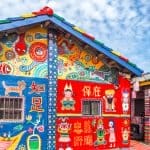
Hi Nick!
My boyfriend and I will be traveling to Penghu Island at the end of April and we’re super excited!! This guide is really helpful. We’re a little confused about what we’d need to rent scooters on Penghu. Do we just need International Drivers Licenses, or do we specifically need International MOTORCYCLE licenses? We’re also open to renting a car, but it sounds like scooters are the way to go.
Thank you!
Katie
Scooters are definitely the way to go. Most of the time, IDP is enough. Most hotels can arrange scooter rentals there, so you could even contact your hotel and ask them if they can arrange it for you to be at the airport when you arrive, or they might pick you up at airport and have scooter ready for you at the hotel. Hotels will probably rent it on your behalf, and hotel owners are the least likely to care about this. I don’t think there’s an international motorcycle IDP (i might be wrong), but I’ve heard just one guy in Taiwan mention that a scooter rental shop wanted proof that he can ride a motorcycle, which he did by checking that person’s home country license to see if it had the correct class for riding motorcycles. I feel this is rare though, and shops on the offshore islands tend to be more chill than ones in bigger cities on the mainland.
Hi Nick,
WOW – I just found your incredible block and I couldn`t stop reading last night, especially your writings about Taiwanese tea is incredible interesting to me.
I am going to Taipei coming Monday March 6th, back to the place where I studied at the Mandarin Training Center way back in the eighties.
I already bought a flight ticket to Penghu, and my question is, if it is possible or a good idea to stroll around with a bicycle?
Best regards, many thanks for all your effort, Heinz
One thing to know is that Penghu is extremely windy in winter. March is the end of winter/start of spring in Taiwan, so it could still be a little windy, which could make cycling more difficult. But as long as the wind isn’t too bad, cycling around would be great. There’s is a fair bit to see and do around Magong, so I bike would be very handy. You can also make longer trips further from the city, such as to one of that island’s beaches. It would be quite far (but still possible) to cycle to the other main islands too. It’s mostly flat, so that helps!
Hi Nick!
Thank you so much for this post. I’ll be a female solo travel. Don’t speak Mandarin. Is it easy to get around and safe?
Thanks! Patricia
Taiwan and Penghu are extremely safe, including for solo female travelers. If you’ve got an driver’s permit (IDP or local taiwanese one), rent a scooter there, then GoogleMaps is all you need.
Hi Nick,
we want to go to Penghu, probably as soon as tomorrow, but sadly we don’t have an IDP. Do yo think it will still be possible to rent a (electric?) scooter?
Thanks
You’re probably already gone, but sometimes on Taiwan’s small islands, you can still manage to if you ask your hotel to rent the scooter for you.
Hi Nick! Thanks so much for this helpful blog. For the day trip options listed here: https://www.kkday.com/en/product/126073?cid=7408 , it seems that there is a Stay Dry tour and a Purple Lavender Forest trip that includes snorkeling for an additional 1500ntd. Do you think it is possible to bring my own equipment to snorkel and still book the Stay Dry tour in order to take the ferry rides? Thanks!
I honestly can’t say for sure without being able to ask the operator. But from personal experience, I will guess that they won’t allow it. With these kinds of tours in taiwan, they tend to move the passengers around like animals, make them follow all the rules, and you can’t do anything by yourself. Even if you are super experienced at snorkeling (as I am), they won’t trust you to go by youself. For local guests (many of whom can barely swim and have no snorkeling experience) they use extreme safety, like making them hold on to ropes while snorkeling, pull them around like that, etc. Which is why I would only guess that they won’t be so lenient with you and just let you bring your own gear and go snorkeling as you wish. Maybe you could try to inqire directly with those local companies once you arrive in Penghu instead of booking it in advance?
Hi Nick,
Thank you so much for the detailed info. Could you please tell me what the payment methods are in Penghu? Is credit card widely accepted in Penghu? Do I need to bring more cash?
Just like almost everywhere in Taiwan, most places don’t take credit cards, except maybe a few big hotels and restaurants. And even some that do, foreign credit cards sometimes don’t work. But there are several ATMs in Penghu so you can easily take out more cash there if needed. It’s not like Xiaoliuqiu where there’s only 1 ATM and it might not work.